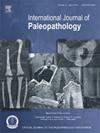Archival pasts and futures in paleopathology
IF 1.5
3区 地球科学
Q3 PALEONTOLOGY
引用次数: 0
Abstract
Objective
This article reviews the role of archival data in past studies and considers their role in the discipline’s future.
Materials
Partial skeletal remains of a woman from the Huntington Anatomical Collection (1893–1921) at the National Museum of Natural History (NMNH) in Washington, DC; collections records and archives from the National Anthropological Archives (NAA) at NMNH; death and almshouse records from the New York City Municipal Archives.
Methods
Skeletal remains were macroscopically observed. Death and almshouse records were transcribed.
Results
The observed shoulder dislocation is analyzed alongside archival texts and is interpreted in relation to gender, industrial labor, trans-Atlantic immigration, and health care.
Conclusions
Integrating skeletal and archival data results in greater contextualization of skeletal pathology, recentering personhood. Incorporating archival datasets raises important questions related to access and restriction. Greater collaboration between archivists, bioarchaeologists, osteologists, and descendant communities or communities of care will be necessary to navigate these emerging questions.
Significance
The reinterpretation of the shoulder injury through archival texts offers an example of paleopathological analysis informed by social and humanist bioarchaeology. The use of archives raises important questions related to stewardship and care of both human remains and archives related to human remains.
Limitations
Not all paleopathological cases have associated archival documents. The case presented here does not demonstrate how to integrate archival data with population-level skeletal data.
Further Research
Archival datasets will play a crucial role in the future of paleopathology; however, methodological, institutional, and ethical concerns that they raise will require collaborations between paleopathologists and archivists.
古病理学档案的过去和未来
目的本文回顾了档案资料在过去研究中的作用,并考虑了它们在学科未来的作用。材料:华盛顿特区国家自然历史博物馆(NMNH)的亨廷顿解剖收藏(1893-1921)中一名女性的部分骨骼遗骸;NMNH国家人类学档案馆(NAA)的收藏记录和档案;纽约市市政档案馆的死亡和救济记录方法对骨骸进行宏观观察。死亡和救济记录都被抄录了。结果观察到的肩关节脱位与档案文献一起分析,并解释了与性别、工业劳动、跨大西洋移民和医疗保健的关系。结论骨骼和档案资料的整合有助于骨骼病理的语境化,重新定位人格。合并档案数据集提出了与访问和限制相关的重要问题。档案工作者、生物考古学家、骨学家和后代社区或护理社区之间的更大合作将是解决这些新出现的问题所必需的。通过档案文本对肩部损伤的重新解释提供了一个由社会和人文主义生物考古学提供信息的古病理学分析的例子。档案的使用提出了与人类遗骸和与人类遗骸有关的档案的管理和护理有关的重要问题。局限性:并非所有的古病理学病例都有相关的档案文件。这里介绍的案例没有演示如何将档案数据与人口级别的骨骼数据集成。进一步研究charchival数据集将在未来的古病理学中发挥至关重要的作用;然而,他们提出的方法、制度和伦理问题需要古病理学家和档案学家之间的合作。
本文章由计算机程序翻译,如有差异,请以英文原文为准。
求助全文
约1分钟内获得全文
求助全文
来源期刊

International Journal of Paleopathology
PALEONTOLOGY-PATHOLOGY
CiteScore
2.90
自引率
25.00%
发文量
43
期刊介绍:
Paleopathology is the study and application of methods and techniques for investigating diseases and related conditions from skeletal and soft tissue remains. The International Journal of Paleopathology (IJPP) will publish original and significant articles on human and animal (including hominids) disease, based upon the study of physical remains, including osseous, dental, and preserved soft tissues at a range of methodological levels, from direct observation to molecular, chemical, histological and radiographic analysis. Discussion of ways in which these methods can be applied to the reconstruction of health, disease and life histories in the past is central to the discipline, so the journal would also encourage papers covering interpretive and theoretical issues, and those that place the study of disease at the centre of a bioarchaeological or biocultural approach. Papers dealing with historical evidence relating to disease in the past (rather than history of medicine) will also be published. The journal will also accept significant studies that applied previously developed techniques to new materials, setting the research in the context of current debates on past human and animal health.
 求助内容:
求助内容: 应助结果提醒方式:
应助结果提醒方式:


